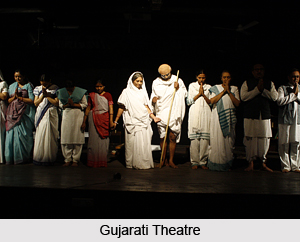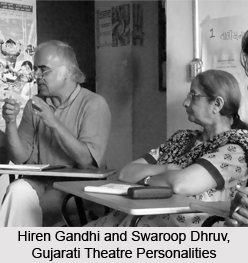 Types of Gujarati theatre can be mainly divided into three main parts. The onslaught of television has affected the output of directors like Nimesh Desai and Bharat Dave, among others in Gujarat responsible for some very interesting productions in the 1990s. Actor-directors now find money and glamour in the electronic medium, not realizing that it cuts both ways: theatre loses and television does not benefit. Elsewhere, the four-decade-old theatre training facilities at the university level have not been very beneficial, nor the efforts to preserve Bhavai, although authentic performers like the female impersonator Chimanlal Naik (1925) did conduct workshops. Furthermore, in the absence of even the semblance of research or serious theatre criticism, most remarkable works go unnoticed and writers get discouraged.
Types of Gujarati theatre can be mainly divided into three main parts. The onslaught of television has affected the output of directors like Nimesh Desai and Bharat Dave, among others in Gujarat responsible for some very interesting productions in the 1990s. Actor-directors now find money and glamour in the electronic medium, not realizing that it cuts both ways: theatre loses and television does not benefit. Elsewhere, the four-decade-old theatre training facilities at the university level have not been very beneficial, nor the efforts to preserve Bhavai, although authentic performers like the female impersonator Chimanlal Naik (1925) did conduct workshops. Furthermore, in the absence of even the semblance of research or serious theatre criticism, most remarkable works go unnoticed and writers get discouraged.
Commercial Gujarati Theatre
The main commercial variety in Mumbai depends on Hindi cinema or Bollywood or Broadway adaptations for easy formulae tied with double-entendre dialogue, commissioned by agents for "contract shows" to societies, ringing the death knell of the box office, which used to form an acid test for their (so-advertised) slick and efficient performance. They sell mystery, tears, jokes and even ideals in high-speed exchanges delivered by smartly costumed casts in fashionable decor, in scripts proudly imported from abroad or Marathi language. However, alongside this activity, notable experiments were conducted by US-based actor-director Chandrakant Shah and others, for instance performing a series of successful Gandhi plays that presented controversial aspects of the Mahatma"s life.
Amateur Gujarati Theatre
The second category is the amateur activity, centred in the cities of Ahmedabad, Vadodara, Surat, Rajkot, and marginally in Mumbai (the Chhabildas experimental movement and Mahendra Joshi),
 where groups stage original plays or classics, following Stanislavskian Method acting or Brecht, Grotowski, and Peter Brook. New drama among these groups seems to have increased: the critic Vinod Adhvaryu evaluated the 1990s as the most notable decade of playwriting; the poet-editor Niranjan Bhagat forecast that the Gujarati play is emerging. Solo scripts were produced in Mumbai and Gujarat on the lives of great writers like Narmad, Kalapi, and Kant. The longest-running troupe is the thirty-year-old Garage Studio Theatre, from which flowered a production, training and media centre with land and partial financial help from the government. A recent theatre movement among the young is led by writer-director Saumay Joshi, who has tackled themes of communal conflict and the sorrows of the common man.
where groups stage original plays or classics, following Stanislavskian Method acting or Brecht, Grotowski, and Peter Brook. New drama among these groups seems to have increased: the critic Vinod Adhvaryu evaluated the 1990s as the most notable decade of playwriting; the poet-editor Niranjan Bhagat forecast that the Gujarati play is emerging. Solo scripts were produced in Mumbai and Gujarat on the lives of great writers like Narmad, Kalapi, and Kant. The longest-running troupe is the thirty-year-old Garage Studio Theatre, from which flowered a production, training and media centre with land and partial financial help from the government. A recent theatre movement among the young is led by writer-director Saumay Joshi, who has tackled themes of communal conflict and the sorrows of the common man.
Developmental Gujarati Theatre
Third category is developmental, socially relevant attempts by non-government institutes and committed troupes like Parivartan (Vadodara), Garage, Chetna, Awaj, and Nehru Foundation (Ahmedabad) who conduct workshops and perform thematic plays for awareness, inspired by Badal Sircar and Augusto Boal, in which the audience is allowed equal participation. Third theatre"s contribution is the emergence of Indian street theatre (Samvedan, Garage, and Lok Kala Manch in Ahmadabad, Parivartan in Vadodara) in efforts to take Gujarati theatre to people at street corners, in middle-class housing colonies, or open public places. Hiren Gandhi and Swaroop Dhruv of Samvedan stage socially conscious plays with actors from the weaker sections of society.
Progress of Gujarati Theatre
On the positive side, the efforts of scholar-designers Goverdhan Panchal (1913-96) and Mansukh Prabhulal Joshi (1922-2000) had a singular effect in creating the right theatre consciousness. Panchal researched and reconstructed classical traditions, while Joshi won respect for work on folk stagecraft. The Sangeet Natak Akademi scheme to encourage young directors discovered talents like Aditi Desai, Janak Rawal, Manvita Baradi, Prabhakar Dabhade, and P. S. Chari. National festivals organized by Rajendra Bhagat, almost every year, brought fresh air and glimpses of newer experiments in sister theatres. One-act competitions over the past fifteen years by the Indian National Theatre and Gujarat Samachar also raised interest among young people




















